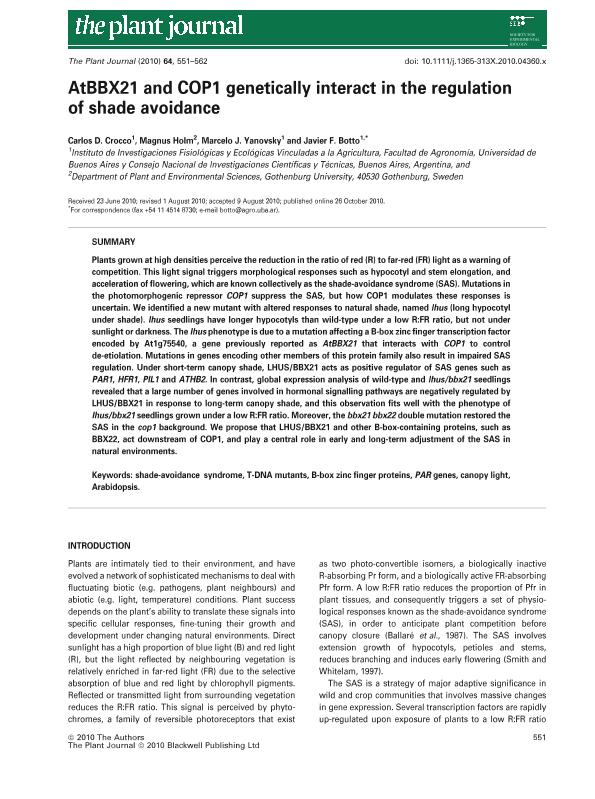Mostrar el registro sencillo del ítem
dc.contributor.author
Crocco, Carlos Daniel

dc.contributor.author
Holm, Magnus
dc.contributor.author
Yanovsky, Marcelo Javier

dc.contributor.author
Botto, Javier Francisco

dc.date.available
2019-03-18T19:24:54Z
dc.date.issued
2010-11
dc.identifier.citation
Crocco, Carlos Daniel; Holm, Magnus; Yanovsky, Marcelo Javier; Botto, Javier Francisco; AtBBX21 and COP1 genetically interact in the regulation of shade avoidance; Wiley Blackwell Publishing, Inc; Plant Journal; 64; 4; 11-2010; 551-562
dc.identifier.issn
0960-7412
dc.identifier.uri
http://hdl.handle.net/11336/71915
dc.description.abstract
Plants grown at high densities perceive the reduction in the ratio of red (R) to far-red (FR) light as a warning of competition. This light signal triggers morphological responses such as hypocotyl and stem elongation, and acceleration of flowering, which are known collectively as the shade-avoidance syndrome (SAS). Mutations in the photomorphogenic repressor COP1 suppress the SAS, but how COP1 modulates these responses is uncertain. We identified a new mutant with altered responses to natural shade, named lhus (long hypocotyl under shade). lhus seedlings have longer hypocotyls than wild-type under a low R:FR ratio, but not under sunlight or darkness. The lhus phenotype is due to a mutation affecting a B-box zinc finger transcription factor encoded by At1g75540, a gene previously reported as AtBBX21 that interacts with COP1 to control de-etiolation. Mutations in genes encoding other members of this protein family also result in impaired SAS regulation. Under short-term canopy shade, LHUS/BBX21 acts as positive regulator of SAS genes such as PAR1, HFR1, PIL1 and ATHB2. In contrast, global expression analysis of wild-type and lhus/bbx21 seedlings revealed that a large number of genes involved in hormonal signalling pathways are negatively regulated by LHUS/BBX21 in response to long-term canopy shade, and this observation fits well with the phenotype of lhus/bbx21 seedlings grown under a low R:FR ratio. Moreover, the bbx21 bbx22 double mutation restored the SAS in the cop1 background. We propose that LHUS/BBX21 and other B-box-containing proteins, such as BBX22, act downstream of COP1, and play a central role in early and long-term adjustment of the SAS in natural environments. © 2010 Blackwell Publishing Ltd.
dc.format
application/pdf
dc.language.iso
eng
dc.publisher
Wiley Blackwell Publishing, Inc

dc.rights
info:eu-repo/semantics/openAccess
dc.rights.uri
https://creativecommons.org/licenses/by-nc-sa/2.5/ar/
dc.subject
Arabidopsis
dc.subject
B-Box Zinc Finger Proteins
dc.subject
Canopy Light
dc.subject
Par Genes
dc.subject
Shade-Avoidance Syndrome
dc.subject
T-Dna Mutants
dc.subject.classification
Otras Ciencias Biológicas

dc.subject.classification
Ciencias Biológicas

dc.subject.classification
CIENCIAS NATURALES Y EXACTAS

dc.title
AtBBX21 and COP1 genetically interact in the regulation of shade avoidance
dc.type
info:eu-repo/semantics/article
dc.type
info:ar-repo/semantics/artículo
dc.type
info:eu-repo/semantics/publishedVersion
dc.date.updated
2019-03-11T14:11:25Z
dc.journal.volume
64
dc.journal.number
4
dc.journal.pagination
551-562
dc.journal.pais
Reino Unido

dc.journal.ciudad
Londres
dc.description.fil
Fil: Crocco, Carlos Daniel. Consejo Nacional de Investigaciones Científicas y Técnicas. Oficina de Coordinación Administrativa Parque Centenario. Instituto de Investigaciones Fisiológicas y Ecológicas Vinculadas a la Agricultura. Universidad de Buenos Aires. Facultad de Agronomía; Argentina
dc.description.fil
Fil: Holm, Magnus. Gothenburg University; Suecia
dc.description.fil
Fil: Yanovsky, Marcelo Javier. Consejo Nacional de Investigaciones Científicas y Técnicas. Oficina de Coordinación Administrativa Parque Centenario. Instituto de Investigaciones Fisiológicas y Ecológicas Vinculadas a la Agricultura. Universidad de Buenos Aires. Facultad de Agronomía; Argentina
dc.description.fil
Fil: Botto, Javier Francisco. Consejo Nacional de Investigaciones Científicas y Técnicas. Oficina de Coordinación Administrativa Parque Centenario. Instituto de Investigaciones Fisiológicas y Ecológicas Vinculadas a la Agricultura. Universidad de Buenos Aires. Facultad de Agronomía; Argentina
dc.journal.title
Plant Journal

dc.relation.alternativeid
info:eu-repo/semantics/altIdentifier/url/https://onlinelibrary.wiley.com/doi/full/10.1111/j.1365-313X.2010.04360.x
dc.relation.alternativeid
info:eu-repo/semantics/altIdentifier/doi/https://doi.org/10.1111/j.1365-313X.2010.04360.x
Archivos asociados
